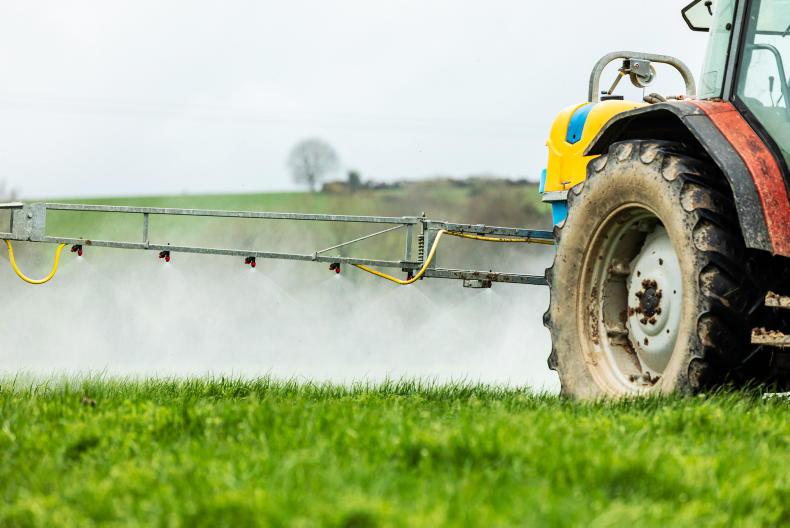There can be little doubt but that a big worry for wheat producers in Ireland is the recent confirmation of SDHI resistance in some isolates of septoria. It is early days yet in terms of what that actually means, but very few would regard it as a surprise and it must be taken very seriously.
Given the sudden and total collapse of the strobilurins against this disease, news of weakening SDHI efficacy is worrying, to say the least. Serious it is, but it is important to keep it in perspective.
It demands a level of discipline in the use of fungicide programmes to help buy time and maintain reasonable efficacy. It is worth noting that the same risk of resistance applies to all products from diseases, weeds and pests and that it is our own livelihoods we are protecting by the sensible use of such inputs.
We should remember that many of the problems we have already encountered have been helped by inappropriate use of products, whether that be the strobilurins or triazoles against septoria or the sulfonylurea herbicides on weeds. There have been many examples. But can we realistically expect that we will see only good practice in terms of the advice and field use of SDHIs and their protection into the future?
The simple answer is no! Low prices mean that growers cannot afford to throw in the kitchen sink in terms of providing backup protection for the SDHIs, but perhaps it will not take an arm and a leg to do this. It is also interesting to note that SDHI-resistant isolates from the field were initially found a number of years ago on the continent. So what has been happening to those isolates and how have populations developed?
Before I get to these comments, it is important to note that we are lucky that Teagasc is our main source of research and advice. It becomes very important to know exactly what is being said by different people and what exactly we are comparing with what. There are many different protocols with regard to how fungicide sensitivity is measured and expressed, and these are not necessarily fully comparable. This can give rise to confusion, which can act to muddy the advice required for future management. And the advice from Teagasc is to protect, in as much as possible, the efficacy of the SDHI actives.
Experience from the continent
Earlier this spring, I spoke to BASF’s John Peck and BayerCropScience’s Andreas Mehl. Both men gave an insight as to what had happened the septoria isolates which showed resistance or reduced sensitivity to SDHI fungicides in those countries.
We know now that SDHI resistance has also been found in other countries, such as Britain, France and Germany. Britain is relatively recent, but reports of less-sensitive isolates were initially found in field monitoring in France and Germany a few years ago.
The first thing that the company representatives said is that there were always outliers or less-sensitive types that were less well-controlled by SDHI actives and that this was the case before this family of fungicides was even introduced. The same is true for virtually every family of actives. These constitute a very low percentage of the total population in nature, but they will increase in time where direct selection pressure continues to be used.
The isolates with reduced sensitivity in France and Germany were possibly the first instances found and it is generally accepted that the chances of finding these outliers in field surveys is quite low, until they increase to about 2% of the total population.
The fact that these isolates with reduced sensitivity to SDHI fungicides have been present for a number of years in France and Germany, affords us the opportunity to examine their progress up to now.
It appears that these less-sensitive types have remained at low levels in the natural population, but surveys appear to show their levels increasing and then decreasing again over time. This might not be expected in an organism if complete resistance is prevalent and if it is fully fit.
So is what has been found in the past total resistance or do the less-sensitive types have some fitness penalty? Are the numbers of the less-susceptible types being drowned out by adverse environmental conditions, such as colder winters or even hotter summers?
The fact that surveys show fluctuating low levels hints at the possibility that the less-sensitive isolates are being supressed by some factor, which may be environmental.
Still good control
There is no indication that field efficacy and control of these resistant septoria isolates has been affected so far in Germany or France. It is common to find resistant strains in trial sites initially, as the range of treatments tested is always more likely to result in more intense selection pressure for reduced sensitivity.
However, thus far it appears that these less-sensitive isolates continue to be overtaken by the general population which appears to be better able to compete than the less-sensitive types when conditions become less favourable.
That said, there is relatively little knowledge as to the specific isolates which account for the reduced sensitivity in these populations. This will now change, as there appears to be an increasing understanding of the individual mutants and their relative fitness or lack thereof.
Power of diagnostics
Molecular resistance analysis is a powerful tool, but it is important to keep it in context, and even more important to understand what the results mean, Andreas said. Resistance can be measured in different ways. From his perspective the C-T79N and C-N86S mutants have a resistance factor (RF) of 10 and this needs to be up around 20+ before it results in real control problems.
In comparison, the G143A mutation, which caused total septoria resistance to the strobilurins, had an RF of closer to 1,000.
Andreas said that the C-H152R mutant has a moderate RF, but that it appears to be rare and may be relatively unfit for that reason. That was one of the isolates found in the Teagasc survey but we still must treat it with the utmost respect until a definite lack of fitness has been fully proven or not. Time will tell.
Both men hinted that that SDHI- resistant isolates found in the open on the continent do not appear, so far, to have the vigour needed to proliferate in the natural population. But that could change. He said that the N225I isolate failed to produce pycnidia on inoculated plants grown in the glasshouse, so this may have difficulty becoming a real problem in the field.
Some other mutants which have been tested actually failed to infect plants in the glasshouse, thus begging the question as to how these survive in the wild. Or do they? It seems that identifying an isolate with reduced sensitivity may not be the same thing as finding a problem.
Resistance development
Andreas commented that SDHI actives (boscalid) are already in the market for 11 years and we are only now finding mutants. He suggested that this is broadly similar to when resistant mutants appeared in the case of some other single-site actives and septoria, ie the strobilurins.
Indeed, it is suggested that mutants and resistance in septoria seem more likely following around 20 applications (two applications per year over 10 years) of a single-site product. But this would not necessarily hold true for all fungicide families or diseases.
The view is that most mutations showing decreased sensitivity may have been part of the population to begin with. These are then selected out over time by the continued use of specific fungicide families.
The use of mixtures will tend to slow or prevent this selection, as the isolates which are less well controlled by one active may be well controlled by another. This is the basis of resistance management.
There is little doubt but that we will find more SDHI-resistant mutants in the coming years and these may be worse than those identified to date, or not. But continued focused active selection pressure is more likely to generate these types and so this must be avoided.
There is always the danger that the ship may already have sailed and that the most we can do is contain the size of the problem for a year or two.
We need to remain aware that many of the mutant isolates found to date only show a moderate decrease in sensitivity to SDHI fungicides. However, one of the isolates found recently by Teagasc is much more resistant and we can only wait to see how this behaves in the overall population.
Slowing disease development
The rate at which any disease can progress is still influenced by the susceptibility of the variety to that disease. Using strong genetic resistance is a huge benefit to help contain the disease. It also helps to slow the rate of multiplication and the pace of build-up of any specific less-sensitive isolates.
The other big factor is the inclusion of azole fungicides with SDHIs in mixtures. Both company people said that the azoles are still effective on those isolates that appear to be less well-controlled by the SDHI actives. Andreas told me that recent studies on mixtures of wild types (susceptible) and SDHI-resistant mutants showed the percentage of the mutant in the population to decrease at every successive generation.
While we in Ireland must hope that this will be the situation in the field, we must continue to act as if this is the biggest threat to the future of wheat production. Because it is the biggest threat until it is proven to be otherwise. The best way to prevent continued selection of SDHI-resistant mutants is to not use SDHI actives. However, this is not totally feasible, because SDHI actives are now our main defence against septoria and they must be used to protect crops already in the ground.
Balanced approach
While the immediate focus is on SDHI resistance, recent experiences in France are interesting. This was one of the first countries where SDHI resistance was found and the authorities there ruled that SDHI actives could only be used once during a growing season (to help protect them).
This meant that triazoles were used alone at the other timings and Andreas told me that this has resulted in a reduction in the efficacy of prothioconazole against septoria. However, the efficacy of epoxiconazole does not appear to have been effected, John said.
This now leaves farmers in France with a much more worrying situation, where the reduced efficacy of the triazole is leaving the SDHI active much more exposed to the development of resistance when it is used. John commented that the single SDHI obligation in France did not slow the development of SDHI resistance in net blotch there.
Commenting on the activity of prothioconazole against septoria, Andreas said that this has remained broadly similar here in Ireland in recent years. However, insensitivity to azoles in septoria has increased substantially in many countries on the continent in recent years. Andreas wonders if the robust programme of mixtures, including chlorothalonil, used here in Ireland is helping to contain resistance development here.
John reminded me that the situation with triazole sensitivity (and mutant populations) in Ireland is different to other EU countries. An example is that Caramba is often the strongest triazole against tritici in Ireland, but this is not usually the case in other countries.
To read the full Crop Protection Focus Supplement, click here.










SHARING OPTIONS